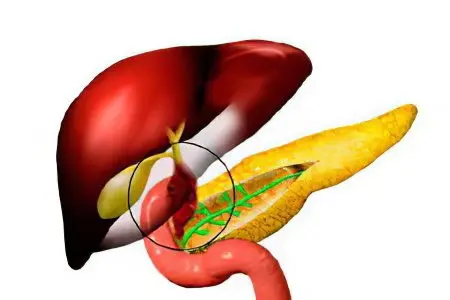Contents

Bile is a special liquid that helps to activate the movement of food through the intestines and at the same time promotes the breakdown of fats. The liver produces it throughout a person’s life. Through the biliary tract, bile enters the intestine, initially entering the hepatic ducts, and then into the common bile duct, which is connected by the cystic duct to the gallbladder. At the junction of the duodenum with the bile duct is the papilla of Vater.
The entry of bile into the intestine is dosed thanks to a special muscle called the sphincter of Oddi. If the contraction function of the gallbladder, its ducts and the sphincter of Oddi is disturbed, then there are problems with biliary excretion, biliary dyskinesia is formed. According to statistics, women are most susceptible to this disease.
Reasons for the development of biliary dyskinesia
Biliary dyskinesia can develop for various reasons:
Due to disruption of the gastrointestinal tract;
Due to the irrational nutrition menu (with excessive consumption of fatty, fried or spicy foods, too long intervals between meals);
As a result of stress and nervous experiences;
In case of hormonal imbalance;
food allergies;
In the presence of worms.
In medical practice, there are two main forms of the disease. One of them is a hyperkinetic form, characterized by an increased tone of the gallbladder due to its excessively strong and rapid contractions. In this case, the sphincters (called “muscular gates”) open partially. As a result, the patient may feel a cutting pain in the right hypochondrium. Attacks are usually short-lived and only in some cases last longer than sixty minutes.
Often they arise for a reason, but as a result of nervous overload, strong unrest, negative emotions. Since the tone of the gallbladder during menstruation is usually increased, in women, an exacerbation of the disease may be associated with the menstrual cycle. Dyskinesia in hyperkinetic form is often noted at a young age. The hypokinetic form of the disease is more susceptible to people of mature age. Its cause is insufficiently intense contraction of the gallbladder.
A symptom of this may also be a sensation of pain in the right hypochondrium. The pain in most cases is prolonged, but not severe, has a dull or arching character. Individual manifestations of the disease are also possible. Based solely on the patient’s complaints, even an experienced doctor will only be able to make a correct diagnosis with great difficulty. Biliary dyskinesia may consist of a series of improvements and exacerbations. After a certain time in the gallbladder and ducts, the formation of gallstones or an inflammatory process is likely.
Violation of the biliary tract can also be manifested by a sensation of a bitter taste in the mouth, a breakdown, or a systematic bad mood. If, after eating spicy salads or after a nervous strain, a person feels pain in the right hypochondrium (acute cramping or dull aching), then you should contact a gastroenterologist as soon as possible. Signs that should alert: loss of appetite and poor sleep, diarrhea or constipation, menstrual irregularities and decreased libido.
Diagnosis of biliary dyskinesia
For the correct diagnosis of the disease, the doctor may refer the patient to additional examinations:
1. X-ray.
2. Biochemical blood test. With a pronounced exacerbation, an increase in the level of liver enzymes is detected in the blood test.
3. Ultrasound.
4. Duodenal sounding – collection of bile for analysis using a gastric tube.
5. Tests using special preparations. A certain medicinal substance is introduced that promotes increased production of bile. In the presence of a disease, bile does not have time to stand out in the intestine and accumulates in the gallbladder and ducts. The ducts expand, and the volume of the bladder increases – this is recorded using ultrasound.
It is extremely important not to confuse biliary dyskinesia with other dangerous diseases that have similar symptoms. Also, during the examination, it is important to establish the form of dyskinesia – the choice of treatment method will depend on this.
Treatment of biliary dyskinesia
One of the necessary conditions for the treatment of this disease is diet. In the hyperkinetic form, it includes fractional nutrition, the minimum amount of products that cause bladder contractions. Preference is given to boiled and pureed dishes, berries and fruits in any form.
In the hypokinetic form, foods that have a choleretic effect are necessarily included in the diet: vegetables, cream, black bread, vegetable and butter, sour cream. In addition to the diet, it is also necessary to follow the course of treatment prescribed by the doctor.
The first symptoms of gallbladder problems that should not be ignored are:









